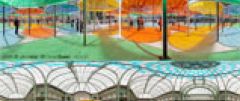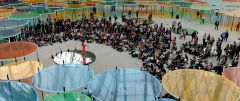Writing
That writing is an important activity for Daniel Buren is made particularly clear in his collected texts Les Écrits, published in 1991 and then in 2012.
Defying the cliché that it is for artists make art and critics and historians to write about it, Daniel Buren does both at once. Through his writing, we see his ideas and oeuvre taking shape. We are privy to his doubts and contradictions, his development and enrichment over the years.
Yet Daniel Buren expects his reader to put his texts into context: they are the writings of an artist, produced at a certain moment, in a particular context, no more and no less. Moreover, in Buren’s case, writing is a direct product of the work: the impetus comes from his art, and its making. Although a few exceptions prove the rule, his texts are not manifestoes intended to guide later creations. And reading them is no substitute for going out and experiencing the works themselves.
Daniel Buren has clearly explained why he writes. A combination of the need and desire to “make up for the lack of good criticism,” a way of stepping back and thinking about art, part of a contract or for sheer pleasure, writing “can talk about things that painting cannot, because painting is visual and cannot talk about itself.”
Visual art and the written word: two systems with their specific features. One cannot be reduced to the other and they do not contradict one another: “Although visual language is essentially “silent,” we can still talk about it, just as we can talk about a good meal without being fed,” says Daniel Buren.
Ranging from group tracts to technical instructions for performing his works, interviews, descriptions, open letters and responses to criticism, this collection of Buren’s writings is an excellent analytical tool and a powerful incitation to experience his oeuvre.





